Livestock Resources for Further Research
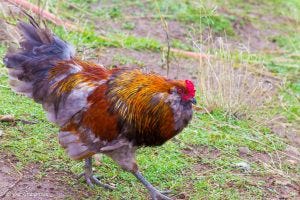
You don't have to have a rooster, but they can be handy to help protect the flock.
Another guest post by my mother, Kathleen Sanderson, in follow-up to the post at Mad Genius Club about livestock in space. This is also useful information if you are planning on keeping small stock while stuck on our current mudball.
There seems to be quite a bit of interest in the animals that colonists might take with them to a new planet, so I thought I’d mention some places you can look for (lots of!) more information.
One of the first places I would suggest looking at is the Oklahoma State University Livestock Breeds website. Just about every breed of livestock in the WORLD is mentioned there, with more or less information, and often with links to websites where you can start digging more deeply. http://www.ansi.okstate.edu/breeds/ I warn you in advance, though – this is a HUGE website! You can get lost in there for hours on end! Just about any breed found in North America will have a website, maybe more than one, so you can use this site as a jumping off place. In addition to the types of livestock commonly seen in America, they have information on yaks, camels, water buffalo, and reindeer, among others.
Next take a peek at the American Livestock Breeds Conservancy website. http://www.livestockconservancy.org/ They don’t have as many breeds, but there are some very interesting articles on the history of many American breeds. They also have links to outside sources of information. There are similar organizations in some other countries, as well – a bit of searching should turn some of those up. (And just because an animal has the same name in two different countries does not necessarily mean it’s exactly the same in both of those countries – just like languages drift, so do breeds of livestock.)
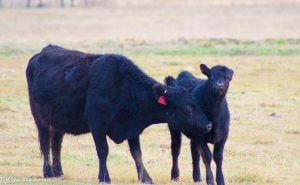
Cows are big, yes, and produce lots of meat and milk, but are not the most efficient use of space.
For basic information on the more common breeds of chickens (and some rare ones) check out the Henderson Chicken Breeds charts: http://www.sagehenfarmlodi.com/chooks/chooks.html They also have a page chock full of excellent poultry resources: http://www.sagehenfarmlodi.com/chooks/chlinks.html And then there is FeatherSite, which is a lot of fun to browse through! http://www.feathersite.com/Poultry/BRKPoultryPage.html Also some of the hatchery sites/catalogs, such as Meyer https://www.meyerhatchery.com/index.a5w , have quite a bit of information in the descriptions of each breed they sell. Meyer isn’t the only hatchery with breed information, but theirs is formatted well – look for the Breed Characteristics box in each listing.
And there is the BackYardChickens website http://www.backyardchickens.com/f/ – keeping in mind that while there are some people there who are serious about their chicken-keeping (and other poultry), there are a lot of, hmm, well, backyard chicken keepers, to whom their birds are pets. If you ask a question, you’ll get a lot of newbies chiming in who may have had chickens for a few weeks to a couple of years – do a little discrimination here and give more weight to information from people who have been keeping poultry for a number of years, and who are at least a little bit scientific about them.
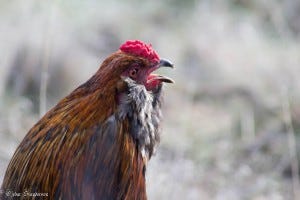
Roosters also make good alarm clocks... sort of.
Here’s one just for fun, but it can keep you busy for a long time if you are interested in the colors chickens can come in, or are just into genetics: Henk’s Chicken Color Calculator. http://kippenjungle.nl/kruising.html?mgt=E:e^b/e^b,Pg:Pg/Pg,Co:Co/Co,Ml:Ml/Ml&fgt=E:E/E
There are a number of worthwhile dog breed sites, as well (some breed information only gives you positives on a breed, leaving the negatives out, but you really need the negatives to make a wise decision). They tend to be geared towards the urban/suburban dog-owner (you’ll see some prejudice against keeping dogs outdoors, for example), but there’s still plenty of good information. Many people only think of dogs as pets, but they are essential to the keeping of most kinds of livestock, and can do all kinds of other work. Here are a couple of general information sites – for more detailed info, search the individual breeds. http://www.animalplanet.com/breed-selector/dog-breeds.html http://www.iams.com/dog-breed-selector https://www.purina.com/dogs/dog-breeds/dog-breed-selector
Sheep are a useful creature; depending on breed, they can give you wool of various types, meat, milk, and sheepskins. Since they are a valuable commercial type of livestock, there have been a number of breed comparisons done. Here are links to a few: http://www.sheep101.info/GeorgesFavoriteBreeds.html
http://www.ranching-with-sheep.com/sheep-breeds.html
This article lays out some of the reasoning that applies to choosing a breed of sheep: whitecloversheepfarm.com/prl-articles/FarmingMagazine...
There’s a book you can read online for free, http://www.nap.edu/openbook.php?isbn=030904295X Microlivestock: Little-Known Small Animals with a Promising Economic Future ( 1991 ). This book covers all kinds of critters: Microcattle, Microgoats, Microsheep, Micropigs, Chickens, Ducks, Geese, Guinea Fowl, Muscovy, Pigeon, Quail, Turkey, Potential New Poultry, Rabbits, Rodents, Agouti, Capybara, Coypu, Giant Rat, Grasscutter, Guinea Pigs, Hutia, Mara, Paca, Vizcacha, Other Rodents, Mouse Deer, Muntjac, Musk Deer, Water Deer, Duikers, Other Small Antelope, Green Iguana, Black Iguana Others, Bees.
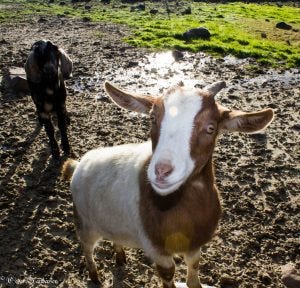
Goats are friendly, efficient, and good for many purposes.
You will notice that this interesting book, while it covers a lot of animals, some already being used as livestock, leaves some important categories out: fish of any kind, including crawdads and shrimp; shellfish; frogs; domestic dogs; most insects; and of course it doesn’t even begin to get into the larger types of animals that might be used as livestock in some situations.
In general, I believe that pretty much every creature on earth that is really suited for domestication has already been domesticated, but that’s not to say that something couldn’t be changed! Sci-fi writers are good at that kind of thing, so if you want your colonists to live on a world where dinosaurs or giraffes are the main domestic livestock, why, go right ahead! Just do your research first! (I’m presently reading Harry Turtledove’s stories about the Roman Legion that got sent into some alternate universe through magic, and, you guessed it, he had BALED hay mentioned in one scene! The machinery for baling hay wasn’t invented until nearly two thousand years later! The CONCEPT of baling hay wasn’t even invented during Roman times. Sigh. Anyway, do your research!)
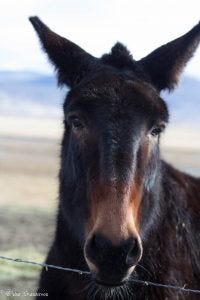
Mules are a hybrid of a horse and a donkey, very hardy, but have a strong personality!



